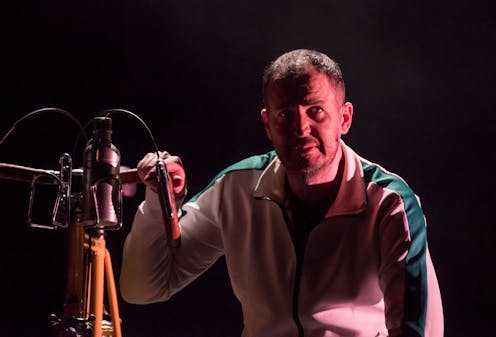on the desire to be great, and the desire to live a life with great meaning
- Written by Catherine Campbell, Lecturer, Performing Arts, UniSA Creative, University of South Australia

Symphonie of the Bicycle is a tour de force. Actor and writer Hew Parham takes the audience through comic and heartfelt parallel stories about the trials and triumphs of the quest to win and to find purpose in life, as seen from the seat of a bicycle.
Symphonie celebrates the life of Italian champion cyclist Gino Bartali, winner of the Tour de France in 1938 and again ten years later in 1948. A parallel story follows a contemporary character, “Hew”, who is warmly and recognisably pathetic, alone and adrift from his track in life.
Bartali is a champion who rejects fame and wants only to ride and make a good life; Hew desperately wants to be noticed and remembered.
In this contrast between the desire to be great and the desire to live a life with great meaning, Parham creates an extensive cast of supporting characters, effortlessly switching between them to great comic effect, or to create moments of breath-holding pathos.
It is a fast-paced, captivating piece and Parham doesn’t miss a beat. I felt joy throughout, and delighted in the small moments of comedy and the huge bellyaching laughs we in the audience shared.
The moments of genuine heartfelt loss and sacrifice were equally effective: Parham’s moments as Bartali where he smuggles documents in his bicycle to help Jewish people escape during the second world war are keenly felt.
An actor’s delight
Chris Drummond directs deftly and with genuine humanity. It is a manically energetic, multi-layered story; Drummond and dramaturg Caleb Lewis have shaped a nuanced and insightful ride over a perfectly paced 90 minutes.
Parham delights in the moments of clowning, switching between a hysterical crying Hew and the “winner coach” Gavin Chestnut. Equally impressive is his physical ability to literally ride through whole scenes, especially in the parallel final races of Bartali and Hew.
Parham creates each character with an actor’s delight in, and love for, their unique humanity. Parham’s extraordinary skill means the audience is with him every step of the way, whether he is narrating the story of Karl von Drais – the volcano-eruption-inspired inventor of the bicycle – or bringing to life Cheryl, the unsuspecting and love-inspired cheese shop attendant.
The collaboration of theatre
The aura of genuinely collaborative work is evident, especially in the delicious sound design and composition of Will Spartalis, incorporating classical music so important to Parham’s clown comedy.
The use of these monumental and profound pieces of music, set against the absurd and profound moment of human life, is a hallmark of Parham’s work. The so-well-known-they-are-almost-clichéd classical works – the Lachrymosa from Mozart’s Requiem, Handel’s Lascia ch’io pianga, Mussorgsky – create an immediate inner world.
A bare stage dominated by a monolithic dark block is brought to life by Wendy Todd’s astonishingly beautiful lighting design. Todd creates gorgeous and rich worlds from deceptively simple designs for each of Parham’s characters to inhabit.
The use of noir-inspired black-and-white moments, the actor fading into shadows and mist, hard white blocks of light on the floor becoming train platforms, a wrestling-ring spotlight for the piñata, the changing weather conditions for the parallel races: this is a masterful element of the storytelling.
Parham uses his voice like an opera singer. The low bass-resonance, gruff Italian-accented English of Bartali is a truly beautiful and memorable rendering of character. His use of the higher, lighter range conveys both calm strength in Bartali’s wife-to-be, and then wife, Adriana, and ruthless comedy in former best friend, and cycling- and life-nemesis, Jake Johnson.
Voice coach Anna McCrossin-Owen brings out the virtuosic contrasts in Parham’s voice, finding nuance in each character. Coupled with Parham’s sometimes bouffon-inspired, sometimes subtle physicality, this enables the audience to create relationships with each character that endure through the story.
Humanitarian comedy
I saw this piece in its first sprint up the mountain, as Symphonie de la Bicyclette, during the Tour Down Under in 2023. There have been some subtle changes and tightening of the script, but it remains a delight of theatre and humanitarian comedy.
The journey of this piece is a testament to how important this kind of high-level collaboration and development time is to an artist and to refining and shaping work for an audience.
The opening night audience saw a well-oiled feat of theatrical engineering; the only noticeable imperfection was a slight echo effect in the actor’s microphone, rapidly and unobtrusively remedied after the first scene.
Symphonie of the Bicycle is a tribute to the value of laughter and comedy and the power of theatre in these ruthless times. May it see many tours and winner’s jerseys.
Symphonie of the Bicycle, from the State Theatre Company of South Australia and Brink Productions, is at the Adelaide Festival Centre until May 25, then touring regionally.
Authors: Catherine Campbell, Lecturer, Performing Arts, UniSA Creative, University of South Australia





